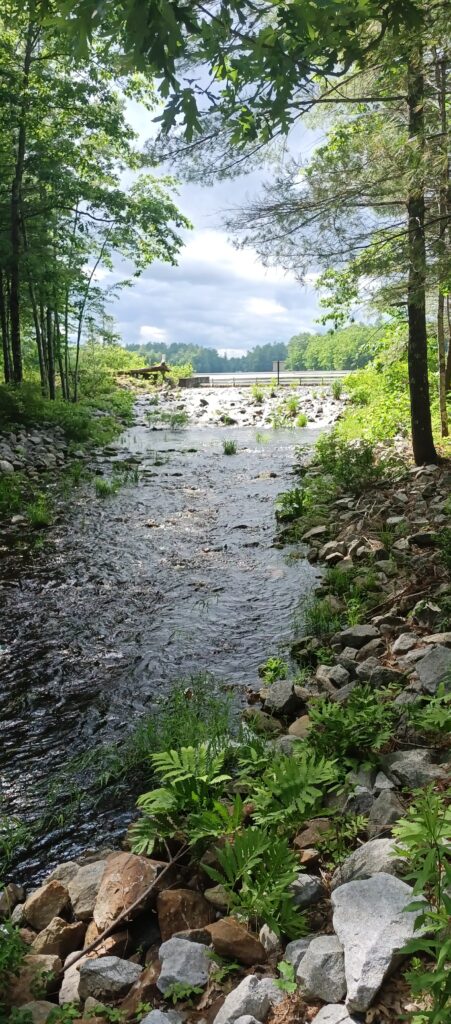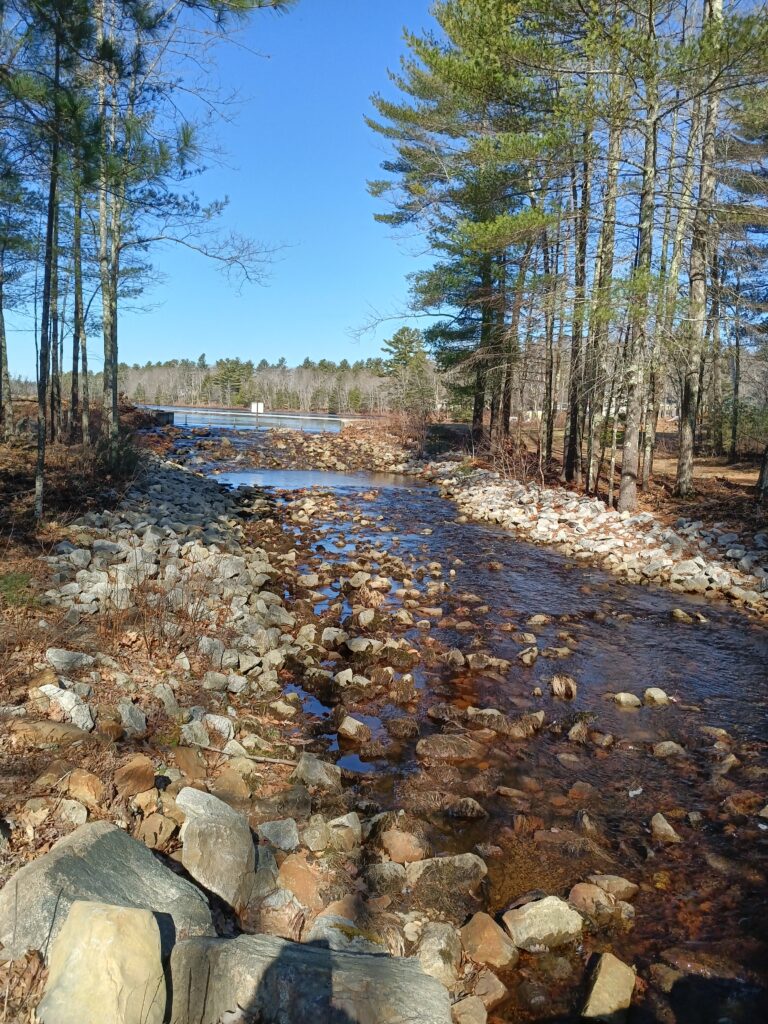History of Wadleigh Pond-Part 1
“The Beginning”
A search of Wadlin (Wadlen, Wadley) deeds prior to 1800 shows only one parcel of land purchased in Coxhall (Lyman). All the spellings were interchangeable in those early deeds! John Wadlin (from Berwick???) purchased 40 acres in Coxhall (Lyman) from George Jellerson on March 29,1793.
The following is the first reference to “Wadlen Mill” and dam is in Volume I of books of town records that lists roads in Coxhall, 1791-1799:
“Road from Wadlen Mill. Southwesterly through Kimball to Joshua Nason’s land, then on the same course to the “South West corner of Captain Nathaniel Gould’s land marked with the letter R, from thence South 20 degrees East on that line betwixt James Maddox and Tad Nason to Robert Gould’s corner, thence on the same line betwixt Robert Gould and said Maddox, South 39 degrees to Roson land, thence on said course to Thomas Clark’s land, and then South Westerly through said Clark’s land 80 rods to the road leading to Clark’s Mill to Joseph Roberts.”
A May 5, 1817 entry references “Road laid out from Wadlins Mill Pond to the road by Thomas Clark Jr’s.”


This is the spillway at our dam. It is probably the location of the original “Wadlin” Mill.
Part 2
“Forty Years Later…”
…John Wadlin is living in Northport, ME and he sold all his land in Lyman to Simeon Chadbourne of Alfred. This is NOT the Simeon Chadbourne on South Waterboro Road in Lyman. The land he sold is the exact lot he had purchased from George Jellison, spelled this way but same person as Jellerson.
John Wadlin was born in 1767 and died in Northport in 1856. HIs wife was Catherine Chadbourne, whose father was Simeon Chadbourne for whom the Chadbourne Cemetery is named. He had a son, John, who was born in Lyman in 1802. This proves he was actually living here and not just running the mill.
Simeon Chadbourne (from Alfred) sold the land to three proprietors (investors) one year later. From then on, proprietors had control of the mill for the next 25 years. One of the proprietors, Magnuss Smith, sold 2/24 of HIS mill priviledge (the buildings, the water flowage, and all the equipment but not the land), of the the Wadley Sawmill to Samuel and James Roberts in 1962. THE HISTORY OF YORK COUNTY (the year 1880) lists “the old Wadleigh Mill near Barker’s Pond” as a manufacturer inEllen Grant Lyman. Notice the evolution of the spelling from “Wadlin” to “Wadleigh”!
In 1882, the fifteen current proprietors of Wadleigh Pond Mill sold a controlling interest to William F. Warren. His wife was Ellen Grant and they had seven children. He died in Portland in 1899. His son, Clinton, received the “Wadleigh Mill” priviledge situated at the outlet of Wadleigh’s Pond two weeks before his father died. Clinton was a teacher and the assumption is, he may not have known how to run a sawmill so he gave it to his brother, Leonard! Leonard knew and he kept it for twelve years, then selling it to Leonard Walker of Saco.
Part 3
JOHN BENJAMIN LUNT
John Benjamin Lunt of North Kennebunkport had already bought the sawmill, grist mill, and flowage at Goodwins Mills. Leonard Walker sold the mill privilege to Lunt in 1918 along with Lunt’s business partner George Whitcomb, Jr. of West Swanzey, New Hampshire. They also bought the whole road to Barkers Pond and a “a lot and the road leading to Wadlin’s Pond from Goodwins Mills. They also bought 10.5 acres around the pond, mill, and the dam. We might be getting the feeling that something big was coming…and it WAS!
In the fall or winter of 1926, a large dam was constructed, creating a much larger pond. A deed between Ralph W. Smith of Saco and the Saco-Biddeford Savings Bank in July of 1927 released Smith from a portion of his mortgage because 22 acres of his land had “been flowed by the new dam of J.B. Lunt at Wadleighs Pond”! Here we are, again, with the current spelling. Wadleigh Pond was now the size that it is today.
John B. Lunt died in April of 1940. He owned the two mills, a brickyard on Alfred Road, and farms where he raised beef cattle. He served in the legislature in 1925. He was clearly a prominent business man. His wife, Ella Nason, died four years later. Both are buried in the Goodwins Mills Cemetery.
The Early History of Our Dam
Steve Lord from the Lyman Historical Society has researched and compiled by Steve Lord from the Lyman Historical Society. The complete 25-page document, including the deeds and maps, will soon be available by email. All details are confirmed by cited sources. Here is a summary.
The earliest reference to Wadlins Mill Pond is from Town of Lyman records May 5, 1817 at a selectmen meeting stating ” a road laid out from Wadlins Mill Pond to the road by Thomas Clark Jr’s when the parties pay Thomas Clark Jr. the damage awarded him” (Volume 1, P. 174). There is deed reference to this litigation in Book 108, P. 208 at York County Deeds.
The earliest deed referencing the Wadley Pond Mill shows Magness Smith of Lyman selling…part of Wadley’s Mill to James Smith in 1862. Another reference refers to a shingle machine two miles north of Goodwins Mills on Wadlin Pond Stream. The Wadley Mill was built using money from proprietors (investors) led by Magness Smith. The names of all the investors is included in the complete document. Many names will be very familiar to the reader. In 1882, a controlling interest in the mill was sold to William Francis Warren. This means they have the ability to mill lumber and sell it.
There is an 1872 map of Lyman showing a tiny pond labeled with SM (sawmill) so this sawmill was built prior to 1872. It’s also shown on an 1885 map of a portion of York County. The first topographical maps were printed in 1884 and two from1889 and 1892 both show a small Wadleigh Pond,
William Warren transferred his “mill privilege” to his son, Clinton, in 1899 and HE transferred it to his brother, Leonard Pitt Warren. HE then sold the “Wadleigh Pond Mill Privilege” to Leonard C. Walker. This brings us to a man who bought a huge amount of property in this area: John Benjamin Lunt.
Deeds show starting in 1918, Lunt bought up property from landowners. He bought the Wadleigh Pond Mill Privilege; the Goodwins Mills to Wadleigh Pond, grist mill/flowage at Goodwins Mills, and the road to Barkers Pond. He then bought ten acres from “Wadleigh’s Mill pond”, a half acre of land by the Wadleigh Pond Dam, a lot and a lot and the road leading from Goodwin’s Mills to Wadlin’s Pond. Lunt was a very influencial man, as his obituary shows. The obituary will be included in the full document.
Lunt continued operating the sawmill there because he owned the mill privileges and a 1927 deed shows “meaning and intending to convey that part of the land of Ralph Smith which has flowed by the new dam of J.B. Lunt at Wadleighs Pond.” The “dam” was probably built in the fall/winter of 1926.


